
The official logo for Mexico's bicentennial and centennial celebrations–yes, both are being celebrated this year.
Mexico's rich heritage and history reach back thousands of years. It's hard to grasp the reality that Mexico is just now celebrating its bicentennial, and even more difficult to hold onto the idea that we are also celebrating our centennial. The bicentennial of what, and the centennial of what? What does it all mean?
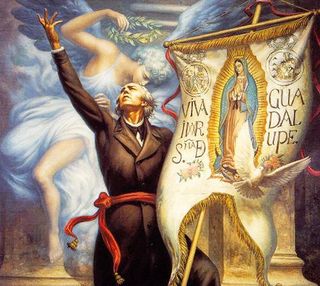
Padre Miguel Hidalgo, whose 1810 cry for freedom from Spain set the fight for independence in motion. His original banner bearing a likeness of Nuestra Señora de Guadalupe (Our Lady of Guadalupe) is part of Mexico's historic patrimony.
Mexico's struggle for freedom from Spanish colonization began
sometime between midnight and dawn on September 16, 1810, when Father
Miguel Hidalgo gave the Grito de Dolores (Cry of Dolores) from
the parish bell tower in the town known today as Dolores Hidalgo,
Guanajuato. Mexico celebrates its Fiestas Patrias (Patriotic Holidays)
on September 16 with parades of school children and military battalions,
politicians proclaiming speeches, and general festivity.
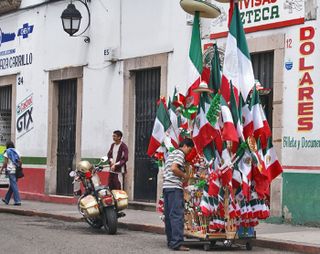
Flag sellers' carts blossom all over Mexico for the two or three weeks before Independence Day.
Hundreds of books have been written about Mexico's break from Spain,
millions of words have been dedicated to exploring the lives of the
daring men and women who knew, a bare 200 years ago, that the time had
come for freedom. You can read some of the history on the Internet. Another excellent source for Mexican history is The Life and Times of Mexico, by Earl Shorris. You'll find that highly readable book available on the left-hand side of this page. Just click on the book cover to order it from Amazon.
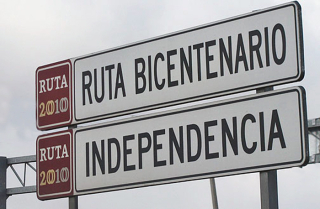
For well over a year, Mexico has been covered with these road signs and others that are similar–to the point that several tourists have asked Mexico Cooks!, "Why are all the highways here called Route 2010?"
In addition to the bicentennial of the beginning of independence from Spain–the original ruta a la independencia–Mexico is also celebrating the 100-year anniversary of the 1910 Mexican revolution. That armed uprising was led by Francisco Madero to protest the long presidency/autocracy of Mexico's President Porfirio Díaz. The roots and facets of the 1910 revolution are complex and the outcome was equally complex. Mexico's Constitution of 1917, which still embodies Mexican law, actually predates the end of the revolution, which many historians peg to 1920. Nonetheless, civil conflict continued to erupt in Mexico until nearly 1930.

Francisco Madero (standing in car waving hat) arriving in Cuernavaca, June 1912. Photo courtesy Wikipedia. Click on any picture for a larger view.
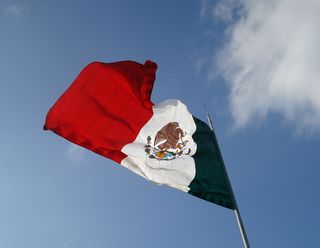
This bandera monumental (monumentally-sized Mexican national flag) waves over one of the highest points in the city of Morelia. In 1999, former Mexican president Ernesto Zedillo Ponce de León initiated the program of oversize flags made to fly over some of Mexico's historic cities. These enormous flags generally measure more than 14 meters high by 25 meters long and fly from 50-meter-high flagpoles.

The balcony of Mexico City's Palacio del Gobierno (government office building). On the night of September 15, President Felipe Calderón will stand on the balcony to give the annual grito (shout) that replicates Padre Hidalgo's rallying cry for independence. In every Mexican town, no matter its size, the elected official will also give the grito during that night.
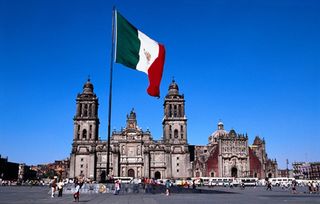
Mexico City's metropolitan cathedral and the zócalo (main square) with its bandera monumental, ready for Independence Day festivities. The 2010 verbena patria (patriotic festivity) in the nation's capital promises to be extraordinary, in keeping with the idea of the bicentennial.
The preparations for the 2010 bicentennial celebration have been enormous, and enormously expensive. In Dolores Hidalgo, Guanajuato, where Hidalgo gave the 1810 cry for independence, the budget for the celebration is more than 550 million pesos. At today's exchange rate, that figure is equivalent to approximately 42 million United States dollars. In Morelia, considered to be the cradle of independence–it was in this city, then called Vallodolid, that the independence conspiracy was developed–the budget is a paltry 28.5 million pesos (a bit over two million United States dollars). Many Mexicans are thrilled with the bicentennial party plans, while many others are outraged at this huge expenditure that comes at a time when Mexico is suffering not only an economic but a political and psychological crisis.
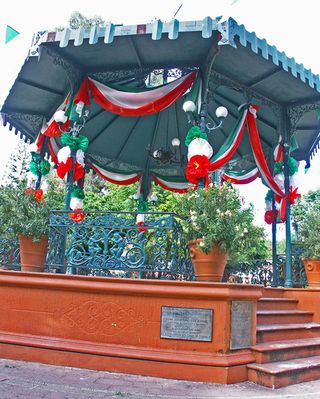
A tiny kiosko (bandstand) in a small-town plaza in the state of Jalisco, decorated for its Fiestas Patrias.
Today, Mexico is as it has always been: a country of profound contrasts. Life parties with death in 2010 just as much as it did in 1810 and 1910. The road behind us and before us is littered with confetti and spent shell casings. Our continuing task is to find la ruta a la independencia (the path to independence).
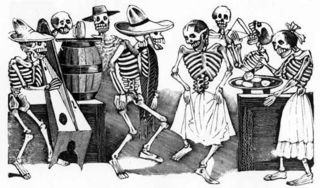
José Guadalupe Posada (1851-1913), La Calavería.
Viva México! Qué viva!
Looking for a
tailored-to-your-interests specialized tour in Mexico? Click here: Tours.
Leave a Reply to Follow Cancel reply